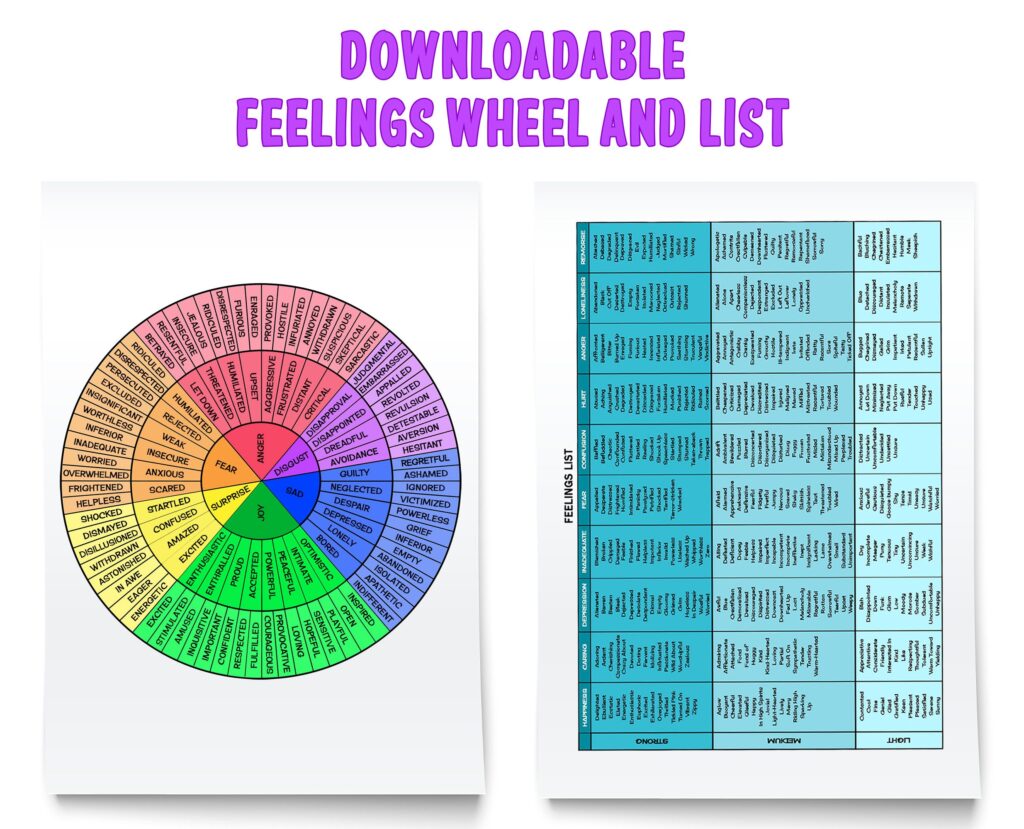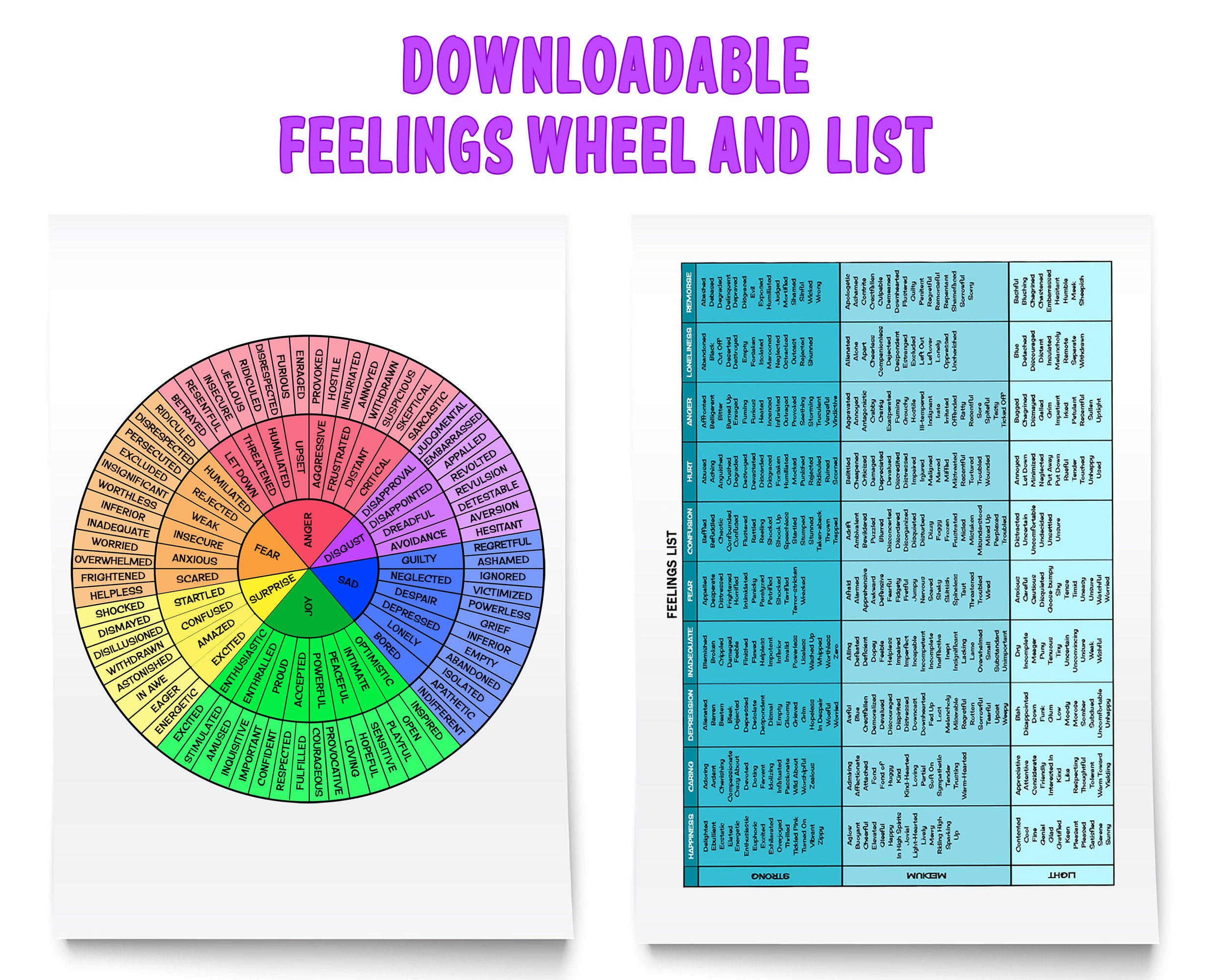
Unlocking Emotional Intelligence: A Deep Dive into the Feelings Wheel
In today’s fast-paced world, understanding and managing our emotions is more critical than ever. The ability to recognize, understand, and express emotions effectively is a cornerstone of emotional intelligence, a skill increasingly recognized as essential for personal and professional success. One powerful tool that can help individuals navigate the complex landscape of human feelings is the feelings wheel. This article will explore the feelings wheel in detail, examining its origins, how it works, and its various applications in improving emotional awareness and communication.
What is the Feelings Wheel?
The feelings wheel, also known as the emotion wheel, is a visual tool designed to help people identify and articulate their emotions. Typically structured as a circular diagram, it presents a hierarchical arrangement of feelings, starting with core emotions at the center and branching out to more nuanced and specific feelings at the periphery. The feelings wheel offers a structured way to move beyond simple labels like “happy” or “sad” and delve into the richer spectrum of human experience.
The most well-known feelings wheel was created by Dr. Gloria Willcox in the 1980s. Her work aimed to provide a comprehensive framework for understanding and expressing emotions in therapeutic settings. Since then, numerous variations of the feelings wheel have emerged, each tailored to different contexts and populations. Despite these variations, the core principle remains the same: to facilitate emotional literacy and self-awareness.
The Structure of a Typical Feelings Wheel
A typical feelings wheel is organized into concentric circles, each representing a different level of emotional specificity. The innermost circle usually contains six primary emotions: happiness, sadness, anger, fear, surprise, and disgust. These are considered the foundational emotions that form the basis for more complex feelings.
The second circle expands on these primary emotions, offering a wider range of related feelings. For example, under the umbrella of “happiness,” you might find feelings like joy, contentment, and optimism. Similarly, “anger” might branch out into frustration, irritation, and resentment. This layer provides a more granular understanding of emotional states.
The outermost circle presents the most specific and nuanced feelings, allowing individuals to pinpoint exactly what they are experiencing. This level of detail is crucial for effective communication and self-regulation. For instance, someone feeling “frustrated” might further identify their emotion as “exasperated” or “aggravated,” depending on the specific context.
How to Use the Feelings Wheel
Using the feelings wheel is a straightforward process, but it requires a willingness to engage with your emotions and explore your inner landscape. Here’s a step-by-step guide:
- Identify the initial feeling: Start by acknowledging that you are experiencing an emotion. It could be a vague sense of unease or a more distinct feeling.
- Locate the feeling on the wheel: Begin at the center of the wheel and work your way outward. Ask yourself which of the primary emotions best aligns with what you are feeling.
- Explore related feelings: Once you’ve identified a primary emotion, explore the surrounding feelings in the second and third circles. Consider which of these more specific feelings resonate with you.
- Pinpoint the exact feeling: Continue to refine your understanding until you can pinpoint the most accurate and descriptive feeling on the outer circle.
- Reflect on the feeling: Take time to reflect on why you are feeling this way. Consider the events, thoughts, and circumstances that may have contributed to your emotional state.
Benefits of Using the Feelings Wheel
The feelings wheel offers a multitude of benefits for individuals seeking to enhance their emotional intelligence and improve their overall well-being:
- Enhanced Emotional Awareness: By providing a structured framework for identifying and labeling emotions, the feelings wheel helps individuals become more aware of their internal states. This heightened awareness is the first step towards managing emotions effectively.
- Improved Communication: The feelings wheel equips individuals with a more precise vocabulary for expressing their emotions. This can lead to clearer and more meaningful communication in personal and professional relationships.
- Increased Self-Regulation: Understanding your emotions is essential for self-regulation. The feelings wheel helps individuals identify triggers and develop strategies for managing challenging emotions in a healthy and constructive manner.
- Stronger Relationships: When individuals can accurately identify and communicate their emotions, they are better able to connect with others on a deeper level. This can lead to stronger and more fulfilling relationships.
- Reduced Stress and Anxiety: By providing a tool for understanding and processing emotions, the feelings wheel can help individuals reduce stress and anxiety levels. When emotions are acknowledged and addressed, they are less likely to manifest as physical or psychological symptoms.
- Increased Empathy: Using the feelings wheel can also enhance empathy. By exploring the range of human emotions, individuals can develop a greater understanding of what others may be feeling.
Applications of the Feelings Wheel
The feelings wheel is a versatile tool that can be applied in a variety of settings:
Therapy and Counseling
Therapists and counselors often use the feelings wheel to help clients explore their emotions and gain insight into their emotional patterns. It can be particularly helpful for individuals who struggle to articulate their feelings or who have difficulty identifying the root causes of their emotional distress. [See also: Cognitive Behavioral Therapy Techniques]
Education
The feelings wheel can be a valuable tool in educational settings, helping children and adolescents develop emotional literacy and social-emotional skills. It can be used in classrooms, after-school programs, and other educational environments to promote self-awareness and empathy.
Personal Development
Individuals can use the feelings wheel on their own to enhance their self-awareness and improve their emotional intelligence. It can be a helpful tool for journaling, meditation, and other self-reflection practices. Regularly checking in with the feelings wheel can provide valuable insights into one’s emotional landscape.
Workplace
The feelings wheel can be used in the workplace to improve communication, teamwork, and conflict resolution. It can help employees better understand their own emotions and the emotions of their colleagues, leading to a more positive and productive work environment. Training sessions incorporating the feelings wheel can foster a culture of emotional intelligence. [See also: Conflict Resolution Strategies in the Workplace]
Parenting
Parents can use the feelings wheel to help their children understand and express their emotions. It can be a helpful tool for teaching children about emotional regulation and building strong, healthy relationships. Using the feelings wheel together can create opportunities for open and honest communication within the family.
Criticisms and Limitations
While the feelings wheel is a valuable tool, it is important to acknowledge its limitations. Some critics argue that it oversimplifies the complexity of human emotions and that it may not be culturally sensitive. It’s crucial to remember that emotions are subjective and can be influenced by a variety of factors, including culture, personal experiences, and individual differences.
Additionally, the feelings wheel should not be used as a substitute for professional mental health care. If you are struggling with significant emotional distress, it is important to seek help from a qualified therapist or counselor. The feelings wheel can be a helpful supplement to therapy, but it is not a replacement for it.
Conclusion
The feelings wheel is a powerful tool for unlocking emotional intelligence and promoting self-awareness. By providing a structured framework for identifying and articulating emotions, it can help individuals improve communication, strengthen relationships, and manage stress and anxiety. Whether used in therapy, education, or personal development, the feelings wheel offers a valuable resource for navigating the complex landscape of human feelings. As we continue to recognize the importance of emotional intelligence in all aspects of life, the feelings wheel will likely remain a relevant and useful tool for years to come. Embracing the feelings wheel is a step towards a more emotionally intelligent and fulfilling life. Remember that understanding your feelings is the first step to controlling them. The feelings wheel is a guide, not a definitive answer. Use it as a tool to better understand yourself and the world around you. The power of the feelings wheel lies in its ability to unlock a deeper understanding of our emotional selves. Another benefit is the promotion of feelings recognition. The feelings wheel promotes emotional vocabulary and helps expand your feelings lexicon. Ultimately, the feelings wheel helps us to process our feelings in a healthy way.

